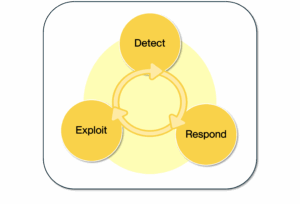Adaptive Strategy | A leadership response to volatility
As Mike Tyson once said, “Everyone’s got a plan until they get punched in the face.”
Are you (or ChatGPT) creating 50-page PowerPoint shelfware for your grand five-year strategy?
Could it be time to start rethinking your approach to strategy?
One of our most popular roundtable guests over the last 12 months was the brilliant Steve McCrone.
Steve is a thought leader in Adaptive Strategy – a new way of approaching strategy for rapidly shifting landscapes.
Here are the seven aspects of this powerful approach.
#1: Context is King – Build a Context for Success
But start with reality as it is, then involve your people to build a shared understanding, a shared context of what success looks like.
This is a clear direction of travel, without pretending to know every step along the way.
It’s about direction, not tightly defined goals.
#2: Heuristics over Policy
If we want business agility, we need to empower people closest to the action, to actually execute on a strategy.
Providing people with heuristics, or rules of thumb, enables them to make decisions quickly that align with the direction of travel.
E.g. For a business pursuing a customer-first strategy, a heuristic might be:
Three customers beat one HiPPO.
For a Lean strategy, it might be: “If it takes more than one handoff, simplify it.”
For a people-first culture, “Call out what matters, not who’s at fault.”
#3: Place Many Small Bets
Refrain from burning resources on dense analysis and heavy budgeting processes to create the perfectly aligned project portfolio.
Instead, run coherent safe-to-fail experiments at the edges. I.e. not a wild, random idea, nor an imported best practice. But something that builds on existing patterns, is legitimate to the people involved (“we can see why this might work here”), and is plausible rather than proven, i.e., it could work, even if we don’t know for sure.
Then keep the feedback fast.
When something works, amplify it. And when it fails, quickly put the fire out, and learn.
We should not that this orientation requires high-trust leadership, giving people space to experiment.
#4: Maximise the Evolutionary Potential of the Present
This is the key principle of making the most of what you have right now.
There’s a heuristic from Human Systems Dynamics that brilliantly embodies this orientation. It goes like this:
What? So what? Now what?

What? — What’s happening right now? What are the facts, observations, data? What did we notice? (This gets you grounded in reality.)
So What? — What’s the meaning? What patterns are emerging? What insights, interpretations can we draw? What might this mean for us?
This is sense-making: deriving meaning from “What”.
Now What? What actions should we take next? Based on what we know and what it means, what experiments, decisions, or next steps will move us forward?
#5: The Detect-Respond-Exploit Cycle
This is the core Adaptive Strategy execution:
 Detect opportunities – sense into the evolutionary potential of your organisation. Flush out the emerging narratives within the business. What are people talking about? Where is the buzz? Look for signals in the customer base.
Detect opportunities – sense into the evolutionary potential of your organisation. Flush out the emerging narratives within the business. What are people talking about? Where is the buzz? Look for signals in the customer base.
Respond with action appropriate to the context. This might be simply to keep executing, to do some analysis, or to run more experiments.
Then we Exploit. We shift resources to what we can see is working and build capability.
#6: Surfacing Dark Contraints
Besides inflexible leadership, another barrier to adopting Adaptive Strategy is the presence of dark constraints.
These are unspoken rules or hidden limits that shape behaviour without being formally acknowledged.
Mostly, these constraints fall into one of these three categories: permission-seeking, fear of failure, or over-attachment to existing norms, i.e. ‘that’s not how we do it.’
To have an adaptive organisation, we must make these dark constraints discussable, then align on creating new norms that address the underlying issue in a transparent way.
Sometimes you may also need to add a constraint — e.g., ‘Run 5 customer experiments this month’ — to force learning while giving freedom in how it’s done.”
#7: The System Concept: Direction–Tempo–Constraints (D–T–C)
We can conceptualise the adaptive organisation following this strategy as follows:
- Direction: the north star – the shared success from pillar 1 above.
- Tempo: cycle speed that matches context, your size of organisation, the market that you’re in – too fast and you might burn out; too slow and you’re at risk of being overtaken.
- Constraints: guardrails that keep movement forward ethical, safe, and aligned to your purpose. If you’re moving without constraint, you risk slipping into chaos; but if it’s all constraints, no movement, you stagnate.
How can you start this, this week?
- Name 3–5 heuristics you want teams to use.
- Set a success statement (direction) without locking in outputs.
- Commit to 3 safe-to-fail experiments in the next 30 days.
- Establish a regular Detect–Respond–Exploit review.
- And, finally, hold a session to uncover at least one dark constraint.
Bottom line: if your strategy still feels too remote to be useful, start employing Adaptive Strategy: direction, tempo and constraints — powered by small bets and fast learning.
If you’d like to explore how to introduce Adpative Strategy to your organisation, let’s talk.
